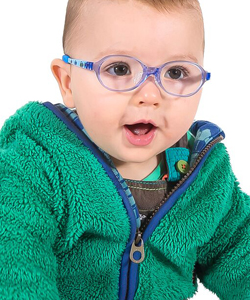Hypertropia and hyperphoria are when the eyes are misaligned – one pointing higher than the other.
Both these forms of eye turn can be well managed by optical lenses and vision therapy.
What is hypertropia?
Hypertropia is a form of vertical strabismus (eye turn), or misalignment of the eyes that occurs when one eye turns upward. When the eye turns downwards it called hypotropia.
Hypertropia is usually diagnosed in childhood, though it can also affect adults as a result of an eye injury or eye disease and can be constant or intermittent— only occurring as a result of fatigue or stress.
Hypertropia is uncommon, occurring in only 1 in 400 children.
Symptoms of hypertropia
- Eye strain
- Headaches
- Double vision
- Tilting head for attempt at clearer vision
What causes hypertropia?
Hypertropia may be either congenital or acquired, and misalignment is due to imbalance in extraocular muscle function. The superior rectus, inferior rectus, superior oblique, and inferior oblique muscles affect the vertical movement of the eyes. These muscles can be paretic, restrictive (fibrosis) or overactive.
Congenital cases may have developmental abnormality due to abnormal muscle structure, usually muscle atrophy/hypertrophy or rarely, absence of the muscle and incorrect placement.
Specific and common causes include:
- Fourth cranial nerve palsy
- Brown’s syndrome
- Duane’s syndrome
- Inferior oblique overaction
- Fibrosis of rectus muscle in Graves Disease
- Surgical trauma to the vertical muscles
1. Fourth cranial nerve palsy
This is the most common cause of hypertropia.
The fourth cranial nerve (IV) sends impulses to the eye muscle that controls the downward movement of the eye. If this nerve is weakened or paralyzed, it cannot properly control the eye muscle, resulting in an upward eye turn.
A child may be born with a weakened or paralyzed nerve, or the never may become damaged following a traumatic brain injury, such as a concussion.
Other names for fourth nerve palsy include superior oblique palsy and trochlear nerve palsy.
2. Brown syndrome
This is a rare condition that causes a tight superior oblique tendon that limits the eye’s movement. Brown syndrome is most commonly seen at birth but can also result from an eye socket injury, or from dental or sinus surgery.
3. Duane syndrome
This is a congenital rare type of eye turn most commonly characterized by the inability of the eye to move outwards.
The syndrome was first described by ophthalmologists Dr. Jakob Stilling (1887) and Dr. Siegmund Türk (1896), and subsequently named after Alexander Duane, who discussed the disorder in more detail in 1905.
Other names for this condition include: Duane’s retraction syndrome, eye retraction syndrome, retraction syndrome, congenital retraction syndrome and Stilling-Türk-Duane syndrome.
How is hypertropia diagnosed?
Through a comprehensive eye exam, your eye doctor can determine the presence of hypertropia through a series of specialized tests.
It is important for hypertropia to be diagnosed when a child is still young, to avoid the development of a lazy eye.
A lazy eye may develop as a result of suppression, when the brain ‘shuts off’ vision from the affected eye to avoid double vision. Suppression occurs as the brain cannot process two different visual signals, one from the straight eye and one from the upturned eye. Consequently, the misaligned eye becomes weaker, and the ‘good’ eye becomes stronger— affecting 3D vision, or depth perception.
Contact an eye doctor near you that are experienced in treating hypertropia.
SEE RELATED: Eye Conditions That Cause Strabismus
Complications from hypertropia
Vertical misalignment may lead to:
- Strabismic amblyopia (lazy eye)
- Cosmetic defect
- Face turn
- Diplopia or double vision
- Suppression of one eye
- Cyclotropia (a deviation of the eyes)
How is hypertropia treated?
In general, hypertropia can be approached and treated with a variety of procedures. Depending on the individual case, treatment options include:
- Eyeglasses
- Prism therapy (for diplopia)
- Vision therapy
- Patching
- Botulinum toxin injection
- Surgical correction
Eyeglasses
Corrective lenses for near or farsightedness can improve eye misalignment. A prism may be added to the lenses for increased improvement.
Patching
Placing a patch over the ‘good’ eye for a few hours each day will force the weaker eye to become stronger.
Vision therapy
Vision therapy works to improve the eye-brain connection and improve vision in the affected eye. Vision therapy may be prescribed in combination with eye glasses, patching or surgery.
Schedule an appointment with a vision therapy eye doctor to start a treatment program.
Surgery
Surgery may help to align the eyes, however it cannot treat the underlying problem, and therefore may not achieve long lasting results— requiring the child to undergo multiple surgeries.
Specialty fellowship trained pediatric ophthalmologists and strabismus surgeons are best equipped to deal with these complex procedures.
Vision therapy, before or after surgery will facilitate the improved neural connections necessary for improved vision and correction of the vertical eye turn.
What is hyperphoria?
Hyperphoria is an eye condition in which the eye points upwards, but not permanently. This usually occurs when the child is tired, stressed, or with the onset of an illness.
Symptoms
The most common symptom of hyperphoria is an upward eye turn that is not present all the time, and only occurs intermittently.
Common signs of hyperphoria include:
- Double vision
- Blurred vision
- Words appear to move on a page
- Eyestrain
- Headaches
- Difficulty concentrating
- Difficulty with reading fluency
- Reduced comprehension
If you experience any of these symptoms contact an eye doctor near you, to diagnose and treat your child’s hyperphoria.
How is hyperphoria treated?
Eyeglasses
Eyeglasses can impact the position of the eye, especially if the child has a high optical prescription or a significant difference of prescription between the two eyes. Eyeglasses may include a prism to allow for the eye turn.
However, while eyeglasses are prescribed to correct the presenting refractive error, they generally cannot treat the cause of the hyperphoria.
Vision therapy
Vision therapy is essential for the treatment of hyperphoria.
Vision therapy may involve the use of specialized tools such as prisms, a series of vision therapy exercises, computer or virtual reality games and vectograms.
Vision therapy will aim to improve the eye position by strengthening:
- Eye coordination
- Convergence ability
- Divergence ability
- Ability to rapidly switch from convergence to divergence
If untreated, hyperphoria may lead to a permanent eye turn or a lazy eye.
LEARN MORE: Guide to Eye Turns
If your child is showing signs of an eye turn, or complains of eye strain or difficulties in reading and learning, schedule an eye exam for a comprehensive evaluation of your child’s vision and ocular health.
The earlier a vision problem is detected, the sooner your child will achieve clear and comfortable vision— necessary tools for academic success!









